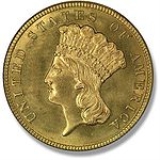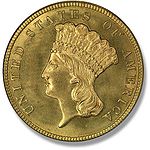
Three-dollar piece
Encyclopedia
| Three-Dollar Piece (United States) | |
  |
The three-dollar piece was a United States
United States
The United States of America is a federal constitutional republic comprising fifty states and a federal district...
coin
Coin
A coin is a piece of hard material that is standardized in weight, is produced in large quantities in order to facilitate trade, and primarily can be used as a legal tender token for commerce in the designated country, region, or territory....
produced from 1854 to 1889. Its value was intended to tie in with the postal system
United States Postal Service
The United States Postal Service is an independent agency of the United States government responsible for providing postal service in the United States...
. At the time, a first class postage stamp
Postage stamp
A postage stamp is a small piece of paper that is purchased and displayed on an item of mail as evidence of payment of postage. Typically, stamps are made from special paper, with a national designation and denomination on the face, and a gum adhesive on the reverse side...
was worth 3¢, and such stamps were often sold in sheets of one hundred stamps. Therefore, the three-dollar piece was exactly enough money to purchase a sheet of stamps. The Treasury Department also withdrew its fractional currency issues starting in the late 1870s, of which there was a 3¢ denomination. A $3 gold coin would have helped facilitate this for those desiring gold in exchange for their 3¢ coins. Despite these potential uses, the coin was minted in small quantities (~535,000 for the entire series, the smallest amount for any series of circulating United States coins), and was never widely used in commerce. Its 1854 purchasing power would be the equivalent of $ today.
Authorized by the Act of February 21, 1853, the coin was designed by James B. Longacre. The obverse depicts a representation of LIBERTY
Lady Liberty
Lady Liberty may refer to:* Lady Liberty , La mortadella, 1972 French-Italian comedy* "Lady Liberty" , written by Al Jardine and Ron Altbach for the Beach Boys...
wearing a headdress of an Indian
Native Americans in the United States
Native Americans in the United States are the indigenous peoples in North America within the boundaries of the present-day continental United States, parts of Alaska, and the island state of Hawaii. They are composed of numerous, distinct tribes, states, and ethnic groups, many of which survive as...
princess and the reverse a wreath of corn
Maize
Maize known in many English-speaking countries as corn or mielie/mealie, is a grain domesticated by indigenous peoples in Mesoamerica in prehistoric times. The leafy stalk produces ears which contain seeds called kernels. Though technically a grain, maize kernels are used in cooking as a vegetable...
, cotton
Cotton
Cotton is a soft, fluffy staple fiber that grows in a boll, or protective capsule, around the seeds of cotton plants of the genus Gossypium. The fiber is almost pure cellulose. The botanical purpose of cotton fiber is to aid in seed dispersal....
, and tobacco
Tobacco
Tobacco is an agricultural product processed from the leaves of plants in the genus Nicotiana. It can be consumed, used as a pesticide and, in the form of nicotine tartrate, used in some medicines...
. The three-dollar piece was .900 gold
Gold
Gold is a chemical element with the symbol Au and an atomic number of 79. Gold is a dense, soft, shiny, malleable and ductile metal. Pure gold has a bright yellow color and luster traditionally considered attractive, which it maintains without oxidizing in air or water. Chemically, gold is a...
and .100 copper
Copper
Copper is a chemical element with the symbol Cu and atomic number 29. It is a ductile metal with very high thermal and electrical conductivity. Pure copper is soft and malleable; an exposed surface has a reddish-orange tarnish...
for a total weight of 5.015 grams. It had a diameter of 20.5 mm with a reeded edge. Quantities were minted in Philadelphia
Philadelphia Mint
The Philadelphia Mint was created from the need to establish a national identity and the needs of commerce in the United States. This led the Founding Fathers of the United States to make an establishment of a continental national mint a main priority after the ratification of the Constitution of...
each year of production, as well as in Dahlonega
Dahlonega Mint
The Dahlonega Mint was a branch of the United States Mint. It was located at 34°31.8′N 83°59.2′W at Dahlonega, Lumpkin County, Georgia. Coins produced at the Dahlonega Mint bear the "D" mint mark. That mint mark is used today by the Denver Mint, which opened many years after the Dahlonega Mint...
, New Orleans
New Orleans Mint
The New Orleans Mint operated in New Orleans, Louisiana, as a branch mint of the United States Mint from 1838 to 1861 and from 1879 to 1909. During its years of operation, it produced over 427 million gold and silver coins of nearly every American denomination, with a total face value of over...
, and San Francisco
San Francisco Mint
The San Francisco Mint is a branch of the United States Mint, and was opened in 1854 to serve the gold mines of the California Gold Rush. It quickly outgrew its first building and moved into a new one in 1874. This building, the Old United States Mint, also known affectionately as The Granite Lady,...
in certain years. Proofs
Proof coinage
Proof coinage means special early samples of a coin issue, historically made for checking the dies and for archival purposes, but nowadays often struck in greater numbers specially for coin collectors . Many countries now issue them....
were officially recorded as being minted at Philadelphia from 1859 to 1889, and only proofs were minted in 1875 and 1876. Proofs of dates prior to 1859 are also known, including extremely rare branch-mint proofs. The total quantity of coins minted each year ranges from 2 for the 1870-S (of which only one has been confirmed to collectors) to 138,618 for the 1854. Today, any specimen has a value of at least several hundred dollars, and the most valuable is the unique 1870-S, currently (2007) valued at $4,000,000 in AU-50. This coin, part of the Harry W. Bass collection, now resides in the American Numismatic Association
American Numismatic Association
The American Numismatic Association was founded in 1891 by Dr. George F. Heath in Chicago, Illinois. The ANA was formed to advance the knowledge of numismatics along educational, historical and scientific lines, as well as enhance interest in the hobby.The ANA national headquarters and museum is...
museum in Colorado Springs.

